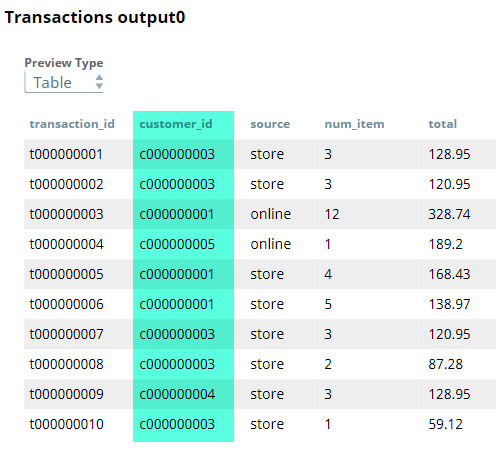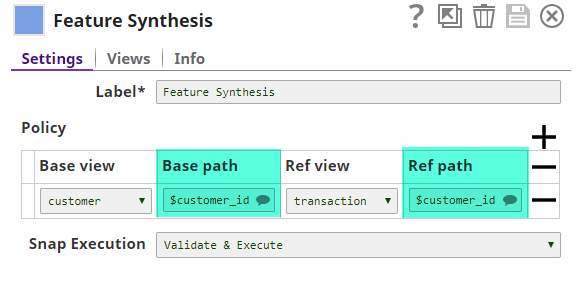Overview
The Feature Synthesis Snap generates new features for base dataset by joining it with other datasets linked together by common identifiers. Features that are generated include:
- Mean
- Min
- Max
- Mode
- Unique
- Count
Input and Output
Expected input
- First input: The base dataset.
- Subsequent input(s): The reference dataset(s).
Expected output: The base dataset containing all the features generated based on the reference datasets.
Expected upstream Snaps: Snaps that offers a document output. For example, MySQL - Select, or PostgreSQL - Select .
Expected downstream Snaps: A Snap that accepts documents. For example, Mapper, JSON Formatter, or AutoML.
Prerequisites
The base dataset must have one-to-many or one-to-one relationship with the reference dataset. Or the reference datasets must have one-to-one or one-to-many relationship with each other.
Configuring Accounts
Accounts are not used with this Snap.
Configuring Views
Input | This Snap has at least two document input views. |
|---|---|
| Output | This Snap has exactly one document output view. |
| Error | This Snap has at most one document error view. |
Troubleshooting
None.
Limitations and Known Issues
None.
Modes
- Ultra pipelines: Does not work in Ultra pipelines.
- Spark mode: Does not work in Spark mode.
Snap Settings
| Label | Required. The name for the Snap. You can modify this to be specific, especially if you have more than one of the same Snap in your pipeline. |
|---|---|
| Policy | Specify the base and reference datasets and fields. |
| Base view | View where the base dataset is the input. Default value: input0 (name of the input view) |
| Base path | The field in the base dataset that is to be used as the base field. This has to be the common identifier for joining with the reference dataset(s). Example: $customer_id Default value: [None] |
| Ref view | View where the reference dataset is the input. Default value: input1 (name of the input view) |
| Ref path | The field in the reference dataset that is to be used. This field must have the same values as in the base field. Example: $customer_id Default value: [None] |
| Snap Execution | TBA once this field's functionality is finalized. |
Examples
Calculating Features in Customer Data Using Transaction Data
This example shows how the Feature Synthesis Snap is used to generate features using a base dataset and a reference dataset.
Download this Pipeline.
Downloads






